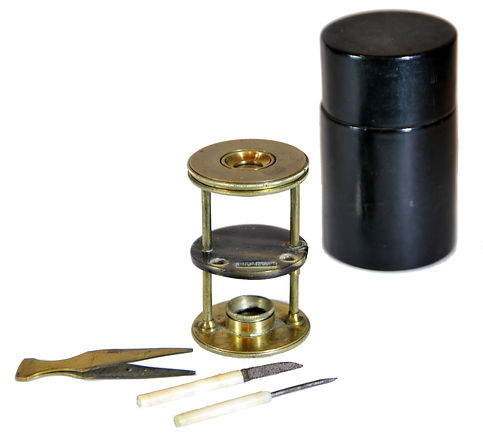

Withering-type botanical microscope, 1780
The “Withering-type Microscope” is named for its inventor, Dr. William Withering (1741-1799), an English physician and botanist who graduated with a degree in medicine 1766 in Edinburgh. Inspired by the taxonomical work and systematic classification of Carl Linnæus (1707-1778), Withering (1776) applied the Linnaean taxonomical system of classification to British plants in a seminal, two volume work, A Botanical arrangement of all the vegetables naturally growing in the British Isles. The earliest reference to a small botanical microscope of Withering’s design appeared in the first edition of this book. There, Withering indicated this microscope was developed for field dissections of flowers and other plant parts. While there is no surviving example of this exact design, close relatives of this type do exist, made either completely of brass or of ivory with brass pillars. Ivory models can be tentatively dated to 1776-1785, as by 1787 a newer model with a hollowed stage in an all-brass configuration already predominated. In turn, it was preceded by the brief appearance of a transitional brass model but with solid stage of ivory or horn (seen here). This version is extremely rare and must have been produced in very small numbers. By 1787 all these varieties were not recorded anymore in the literature.

Withering-type botanical microscope, 1780
The “Withering-type Microscope” is named for its inventor, Dr. William Withering (1741-1799), an English physician and botanist who graduated with a degree in medicine 1766 in Edinburgh. Inspired by the taxonomical work and systematic classification of Carl Linnæus (1707-1778), Withering (1776) applied the Linnaean taxonomical system of classification to British plants in a seminal, two volume work, A Botanical arrangement of all the vegetables naturally growing in the British Isles. The earliest reference to a small botanical microscope of Withering’s design appeared in the first edition of this book. There, Withering indicated this microscope was developed for field dissections of flowers and other plant parts. While there is no surviving example of this exact design, close relatives of this type do exist, made either completely of brass or of ivory with brass pillars. Ivory models can be tentatively dated to 1776-1785, as by 1787 a newer model with a hollowed stage in an all-brass configuration already predominated. In turn, it was preceded by the brief appearance of a transitional brass model but with solid stage of ivory or horn (seen here). This version is extremely rare and must have been produced in very small numbers. By 1787 all these varieties were not recorded anymore in the literature.
References: SML: A242712; Goren 2014.
References: SML: A242712; Goren 2014.
Prof. Yuval Goren's Collection of the History of the Microscope
Moritz Pillischer “Lenticular” Microscope




Moritz Pillischer's journey from Hungary to London in 1845 heralded an exciting era of scientific innovation! By 1849, he had opened a vibrant independent shop, where he crafted microscopes and scientific instruments that captured the interest of many. While his products may not have matched the precision of top English manufacturers, they were renowned for their quality and affordability. Moritz's microscopes received numerous awards at international exhibitions, proudly displayed on their labels. His legacy when his nephew, Jacob—fondly called "James"—joined him in London and later married one of Moritz's daughters. In 1887, Moritz entrusted his thriving business to the next generation, who upheld his passion until its closure in 1947. Pillischer operated at the address noted on this instrument between 1851 and 1853. The trough-like rectangular stage of this microscope is made of oxidized brass and measures approximately 0.9 mm thick. The inner dimensions of the trough are roughly 27.5 x 77 mm, indicating it was designed for use with standard 1 x 3 inch (25.5 x 77 mm) slides. A small black and white disk, 22.5 mm in diameter, was also included for viewing opaque objects, though there is no apparent method to secure this disk on the stage.
The accessories consist of a black and white ivory disk and three, each with an approximate outer diameter of mm. Two lenses are kept in slots within the case, while the third is attached to the microscope arm. Early descriptions of this microscope it may have originally included a glass depression slide, which is also with other existing specimens. A replacement depression slide has been included in this set, similar to the original, is stored on the stage.
The microscope was promoted in The Lancet in 1853 and in the British Medical Directory in 4. The1857 edition of the Encyclopedia Britannica included a description of it under the entry for 'Microscope.' Additionally, as shown above, the Form was depicted in Golding Bird fourth edition of Urinary Deposits 1853. It was also featured in advertisements at the back of Quekett's book published in 1855.


